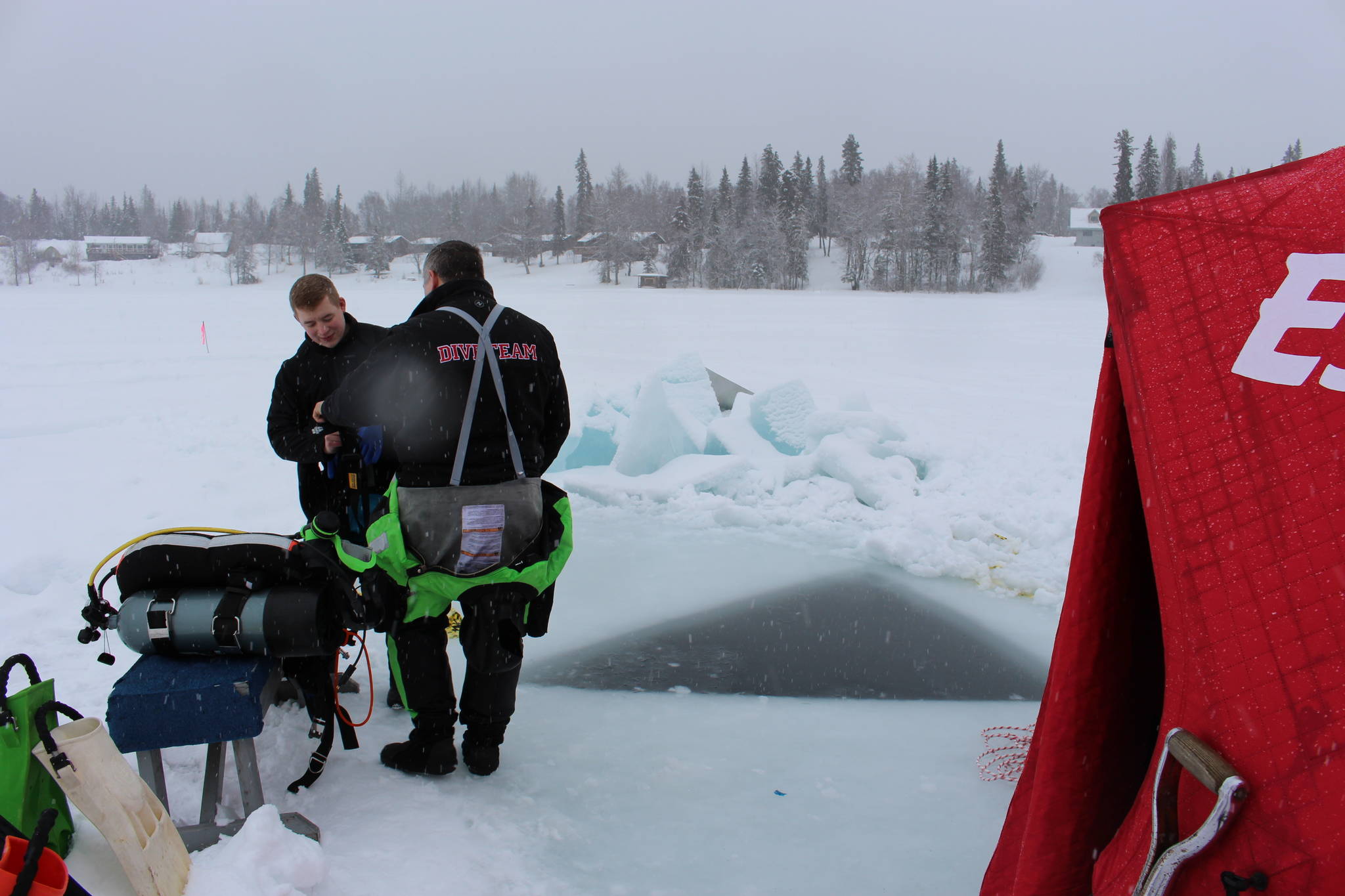The coronavirus may have put the Nikiski Fire Department’s upcoming dive team training on hold, but that didn’t stop three of its dedicated members from spending a weekend training on their own.
“There’s a lot of stuff going on, we get it,” Stephen Robertson, Nikiski’s senior captain and training officer, said. “But at the same time it’s like, I can sit at my house all day, or I can go ice diving. In that case, I’m gonna go ice diving.”
Robertson, T.J. Cox, Nikiski firefighter and paramedic, and dive master Tony Gillham met up on Saturday to practice their skills and work toward refreshing their ice-diving certification.
Robertson said that the fire department’s eight-member dive team typically practices ice diving every quarter in order to stay fresh on their training, so many of the divers are still doing it on their own time in the wake of the cancellations.
“It’s an important side of our public safety team,” Robertson said. “And if someone goes under the ice, you don’t want the last time you dove to be seven months ago.”
The three divers met at Gillham’s house on Saturday, which sits on Island Lake in Nikiski. The diving area was set up last week and was still in good shape for the day’s dives. A triangle-shaped hole about 5-feet long on each side was cut into the ice, which Robertson said was about 2-feet thick. A tent was set up near the hole for the divers to warm up between sessions, and the snow on the lake’s surface had been shoveled away to form a large semicircle that extended 60 feet out from the hole.
Robertson said removing the snow in such a way allows more light to penetrate the ice, and the divers can then use that ring of light as a track to follow while they’re under the water, while another line leads directly from the outer ring back to the hole in the center. There were markers surrounding the dive area and signs indicating an emergency operation in place, and Robertson said that they cover up the hole each night for safety purposes.
Robertson said that he likes using Island Lake for dive practice because he’s become very familiar with its depth changes and general layout. The lake is also a popular recreation area, so it’s possible that the dive team might be called out there for a rescue at some point. The part of the lake where the divers were practicing on Saturday was between 15- and 20-feet deep.
Divers need to complete three, 20-minute ice dives in order to be certified, Robertson said, and they cannot perform all three in one day. Cox was attempting his first and second dives on Saturday. Gillham was knocking out his second and third dives.
Robertson said that one of the notable differences from other forms of diving, other than the ice, is that divers are attached to a rope held by someone on the surface.
“A lot of the times we dive to have freedom,” Robertson said. “Because it becomes a 360 world. You can go up, down, left, right, anywhere you want to go, and now all of a sudden you’re tethered to something.”
Cox had a new dive suit that he had only worn once in a recreational saltwater dive, and Saturday added and removed lead-filled pouches from his suit to test how much weight he would need in order to maintain the proper buoyancy underwater.
The divers’ dry suits were equipped with two oxygen tanks, a buoyancy-compensating device, two breathing regulators, full face masks, fins, and a wireless communications system that allowed the divers to talk to each other as well as the person on the surface.
The divers took their time gearing up on Saturday, but Robertson said when responding to an emergency, the dive team can go from street clothes to full scuba gear in about a minute.
In addition to have the wireless communication set up, the divers also used the attached rope to communicate with the tender on the surface. Gillham, who is a certified dive master and assists Robertsons with his trainings, said that if he tugs on the rope once, it’s to signal to the divers that they’re about to run out of rope. Two tugs essentially asks “Is everything OK?” And the divers respond with two tugs if there are no problems. If the divers pull on the rope three times, it means they need more rope. Four pulls is reserved for things specific to the situation. For example, if the divers are looking for a person or item underwater, four pulls would indicate that they’ve found it. Five pulls from the divers mean that something has gone wrong.
Other than Robertson having issues with one of his regulators, for which he had a backup in his truck, Saturday’s dives were completed successfully.

